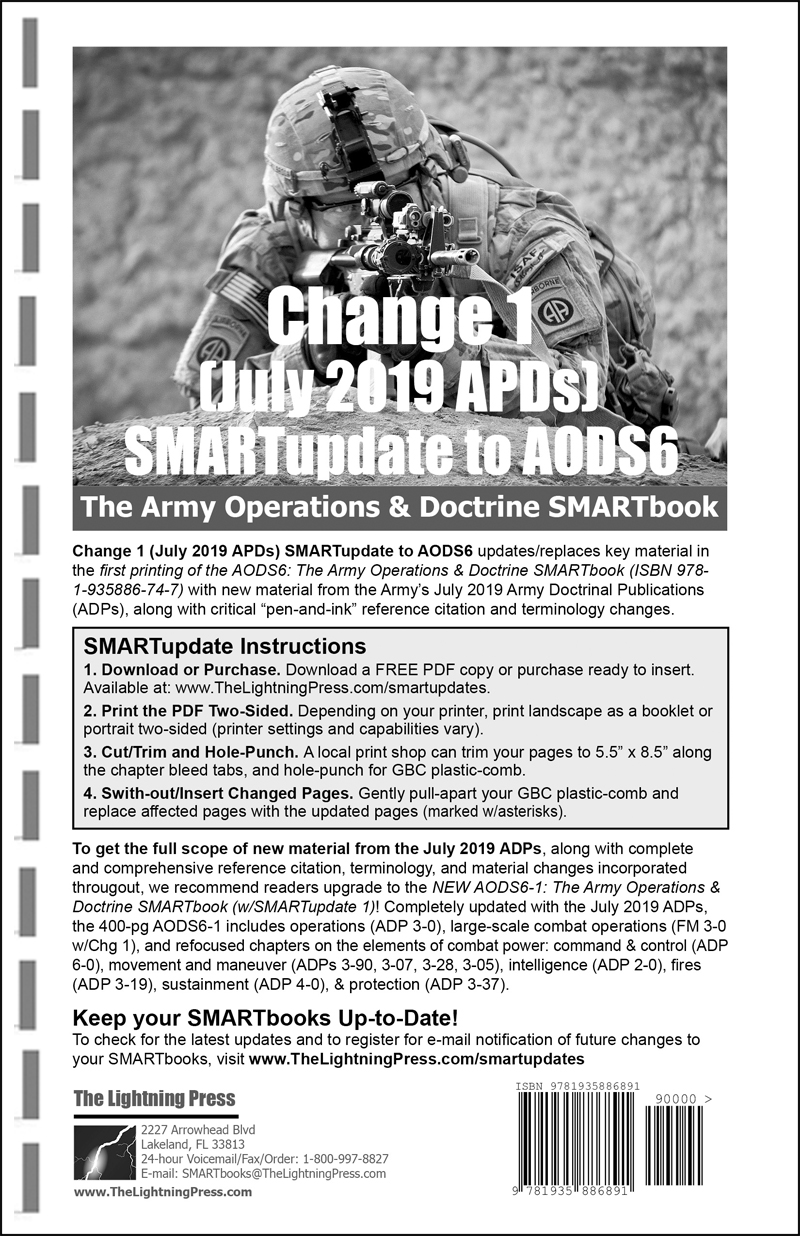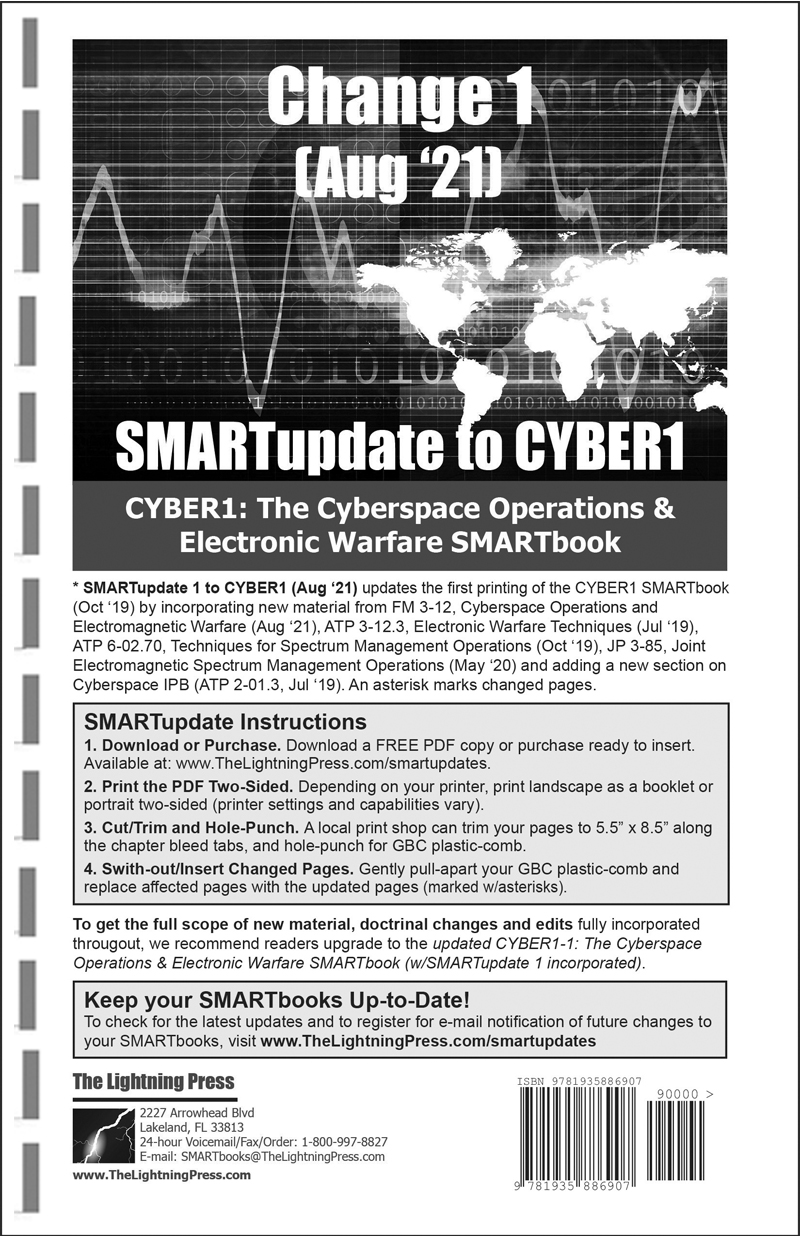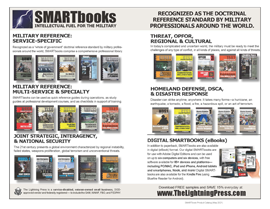Military Reference: Service-level
Military Reference: Service-level
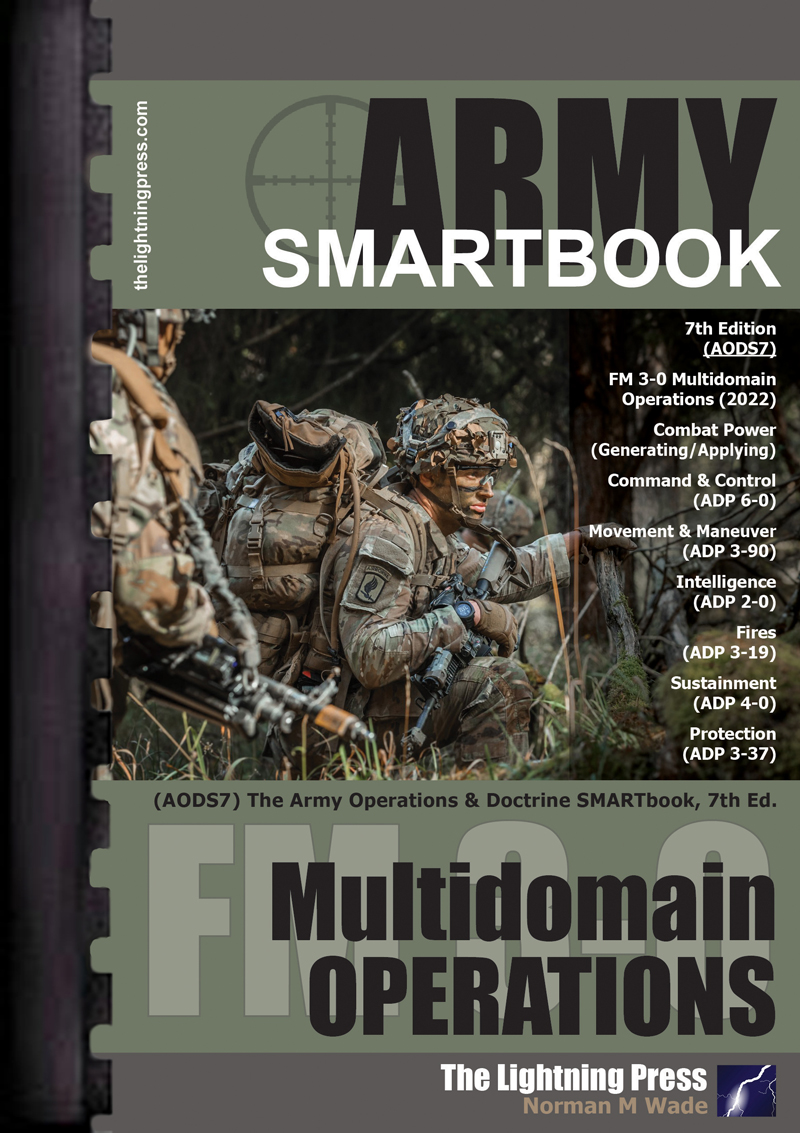
AODS7: The Army Operations & Doctrine SMARTbook, 7th Ed.
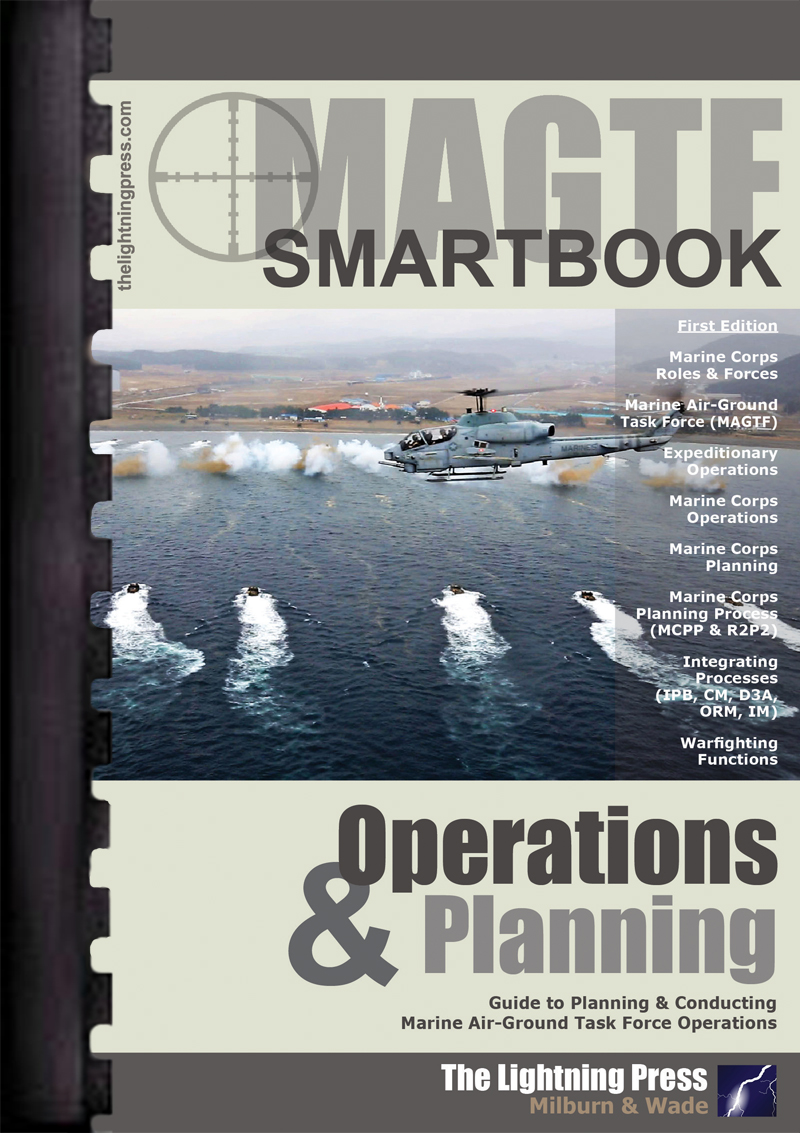
MAGTF: The MAGTF Operations & Planning SMARTbook
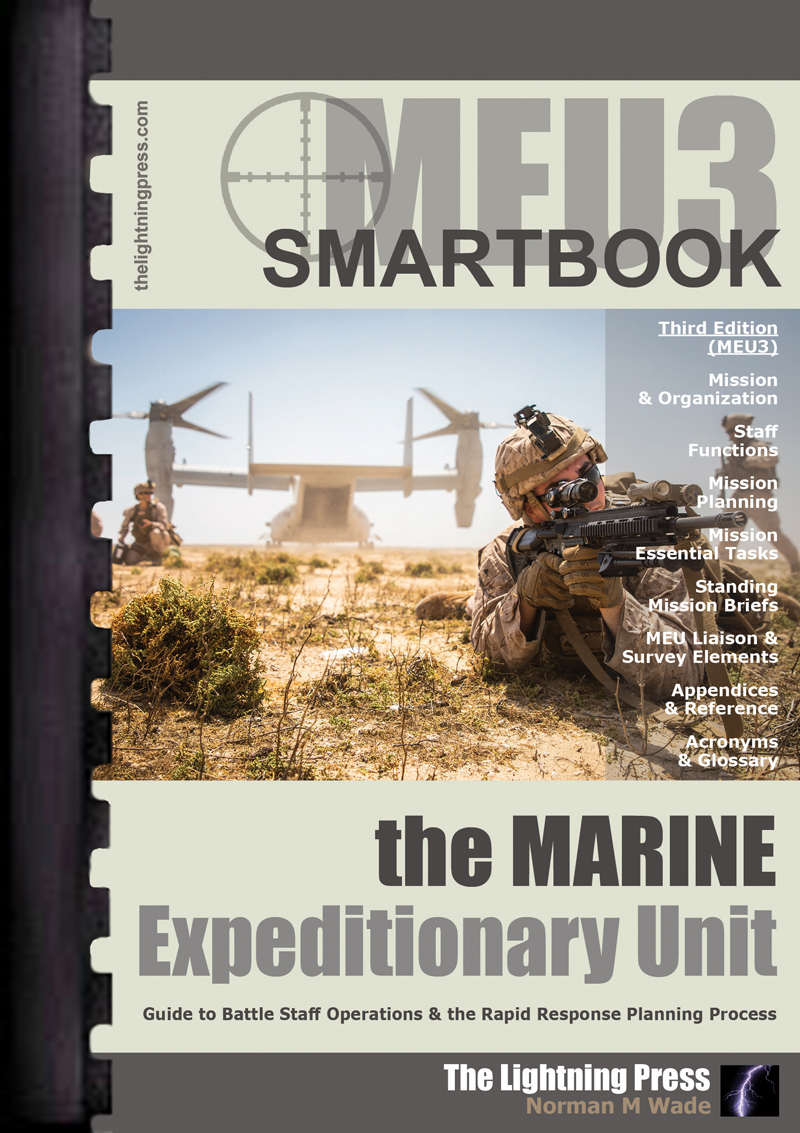
MEU3: The Marine Expeditionary Unit SMARTbook, 3rd Ed.
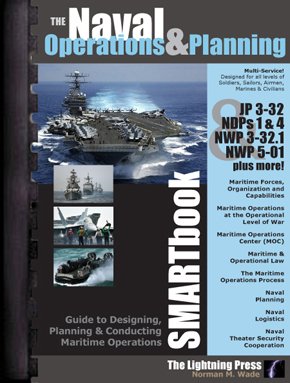
The Naval Operations & Planning SMARTbook
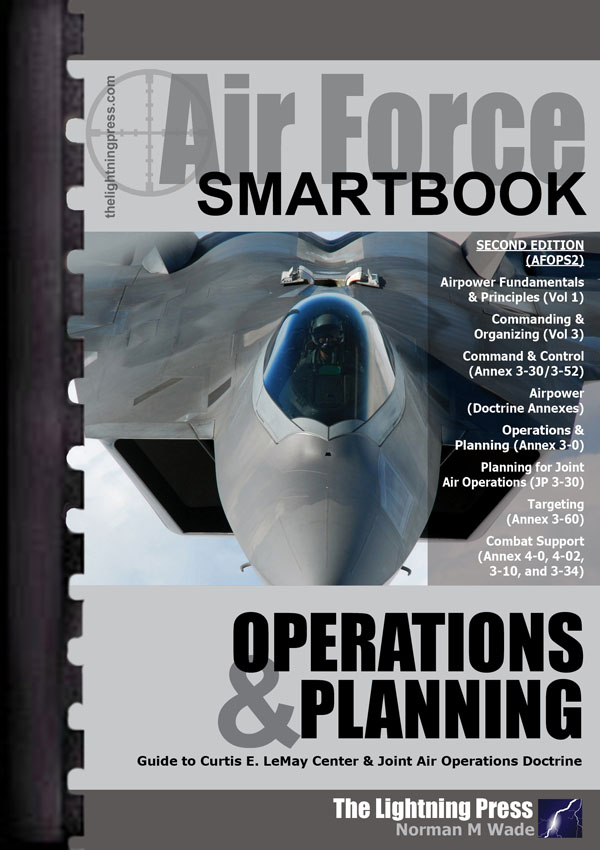
AFOPS2: The Air Force Operations & Planning SMARTbook, 2nd Ed.
Military Reference: Multi-Service & Specialty

BSS7: The Battle Staff SMARTbook, 7th Ed.

SUTS3: The Small Unit Tactics SMARTbook, 3rd Ed.
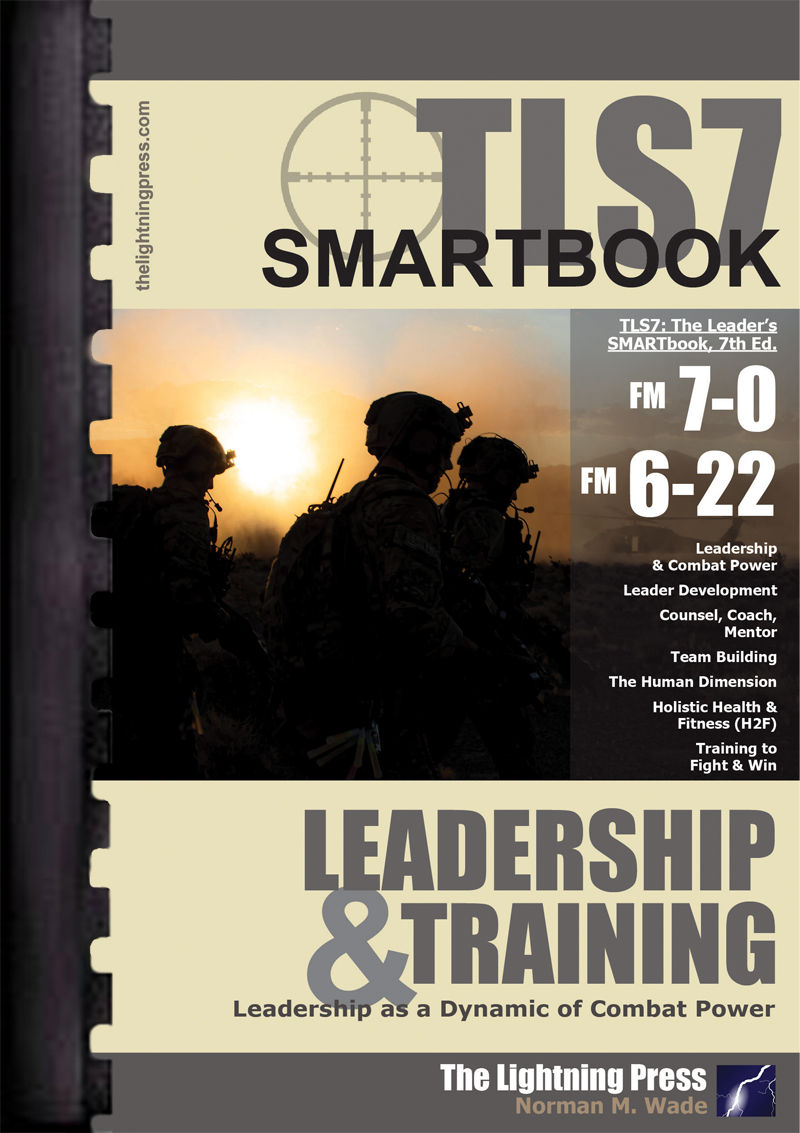
TLS7: The Leader’s SMARTbook, 7th Ed.
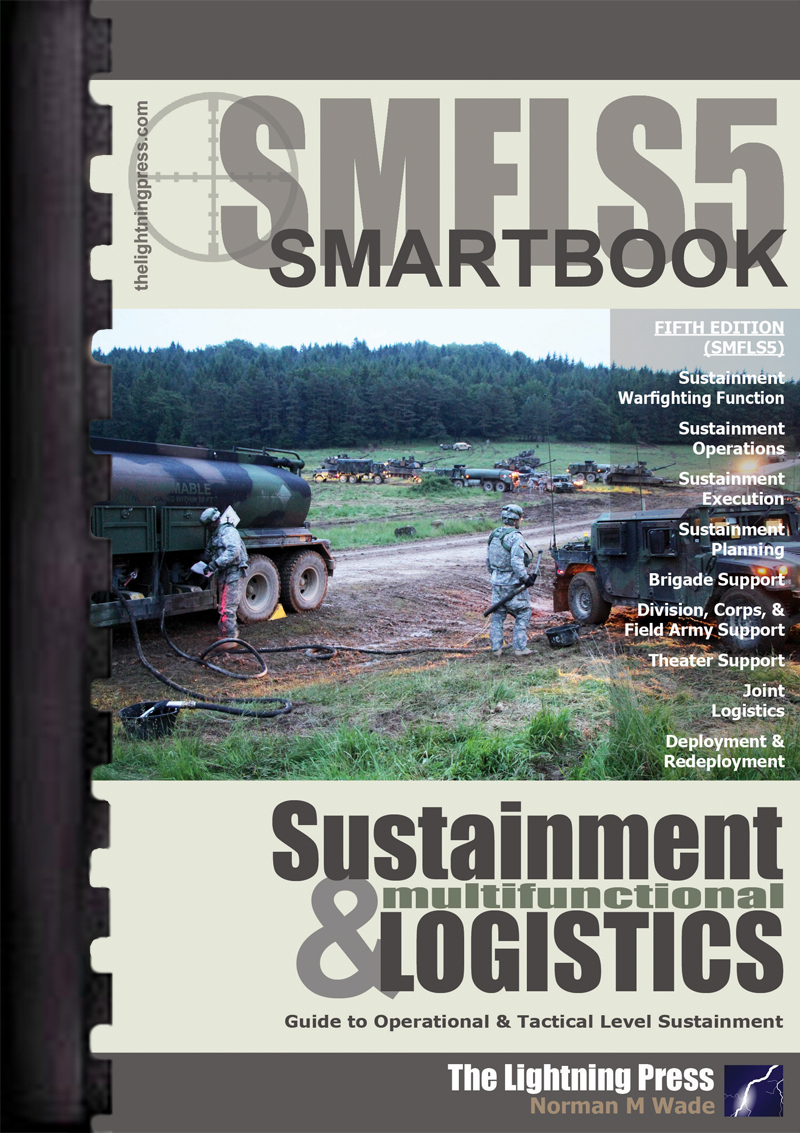
SMFLS5: The Sustainment & Multifunctional Logistics SMARTbook, 5th Ed.
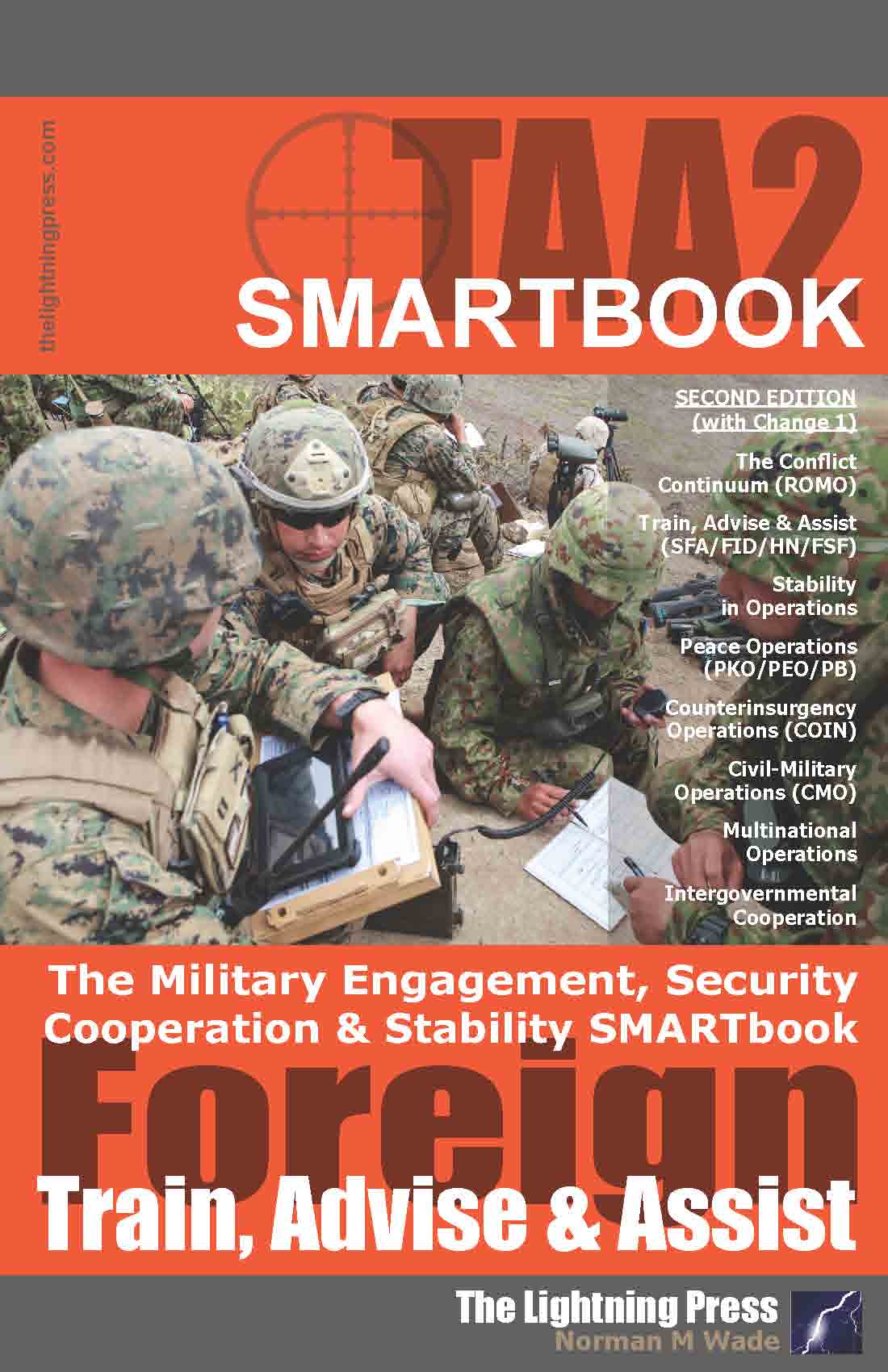
TAA2: The Military Engagement, Security Cooperation & Stability SMARTbook, 2nd Ed. (w/Change 1)
Joint, Strategic, Interagency, & National Security
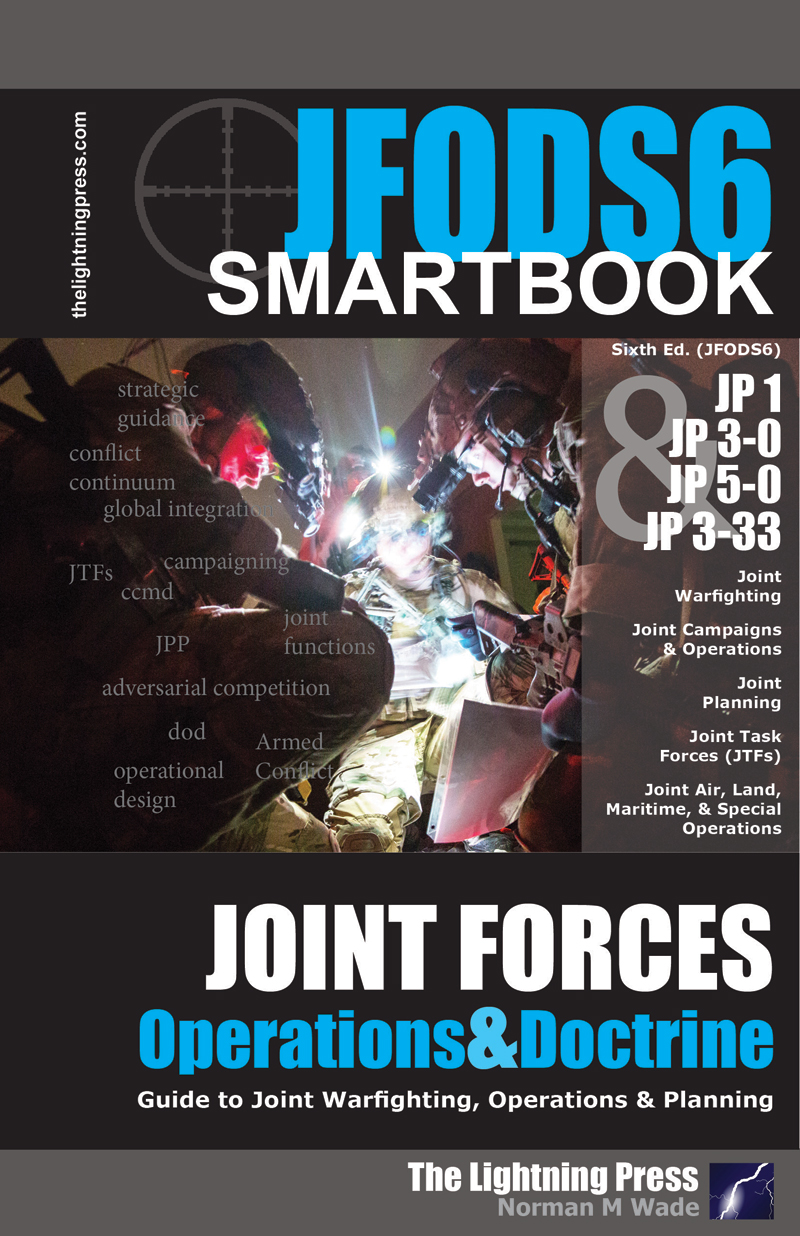
JFODS6: The Joint Forces Operations & Doctrine SMARTbook, 6th Ed.
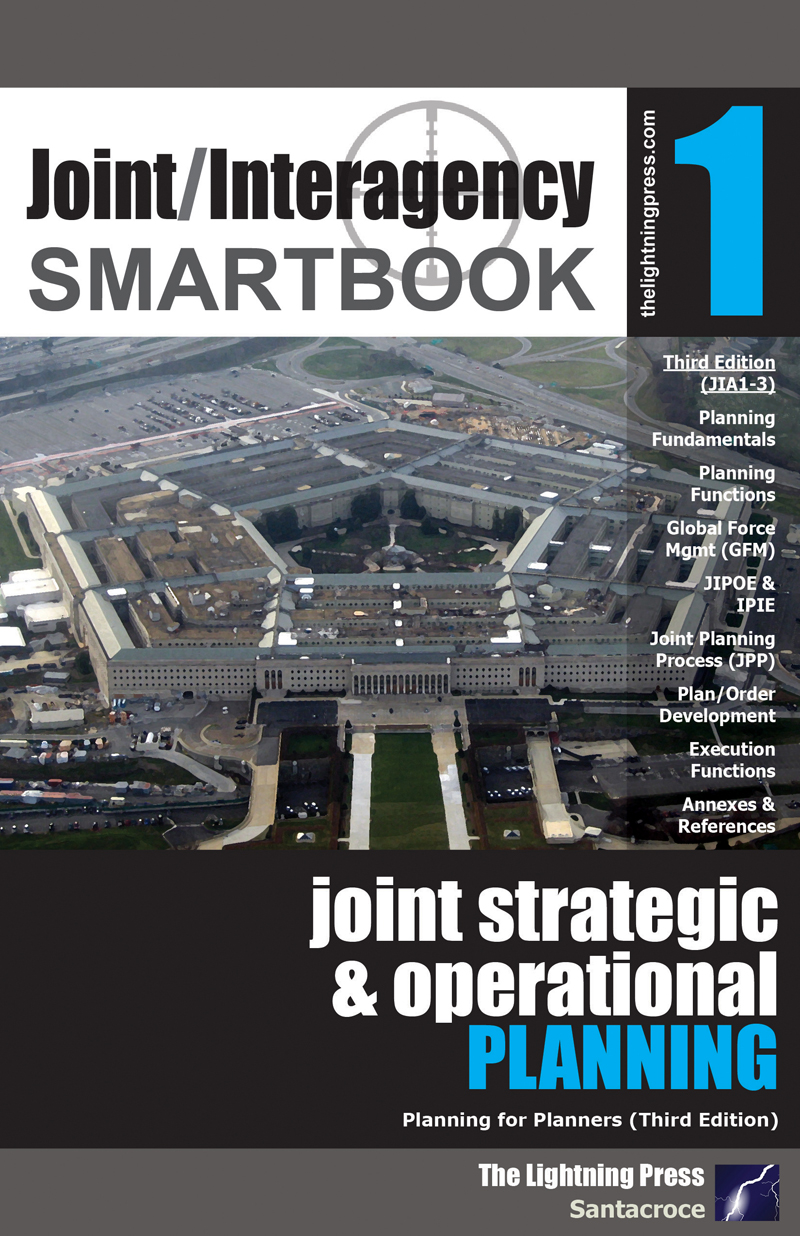
Joint/Interagency SMARTbook 1 – Joint Strategic & Operational Planning, 3rd Ed.
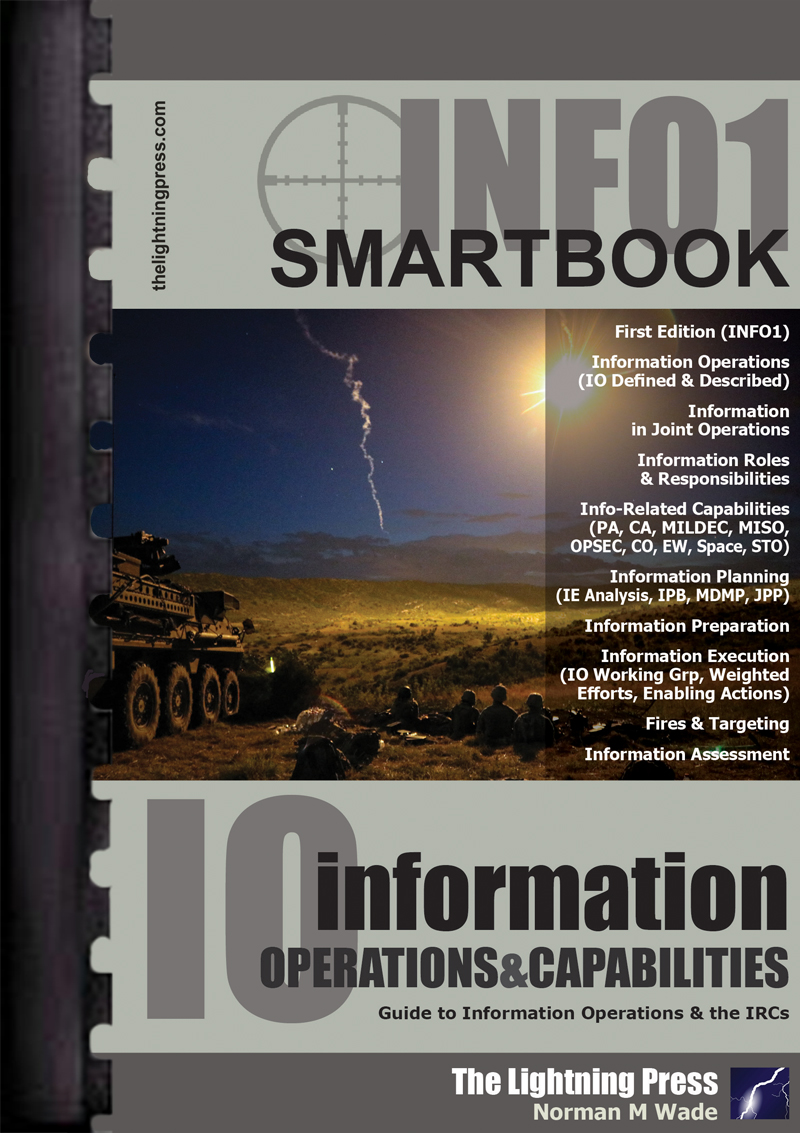
INFO1: The Information Operations & Capabilities SMARTbook
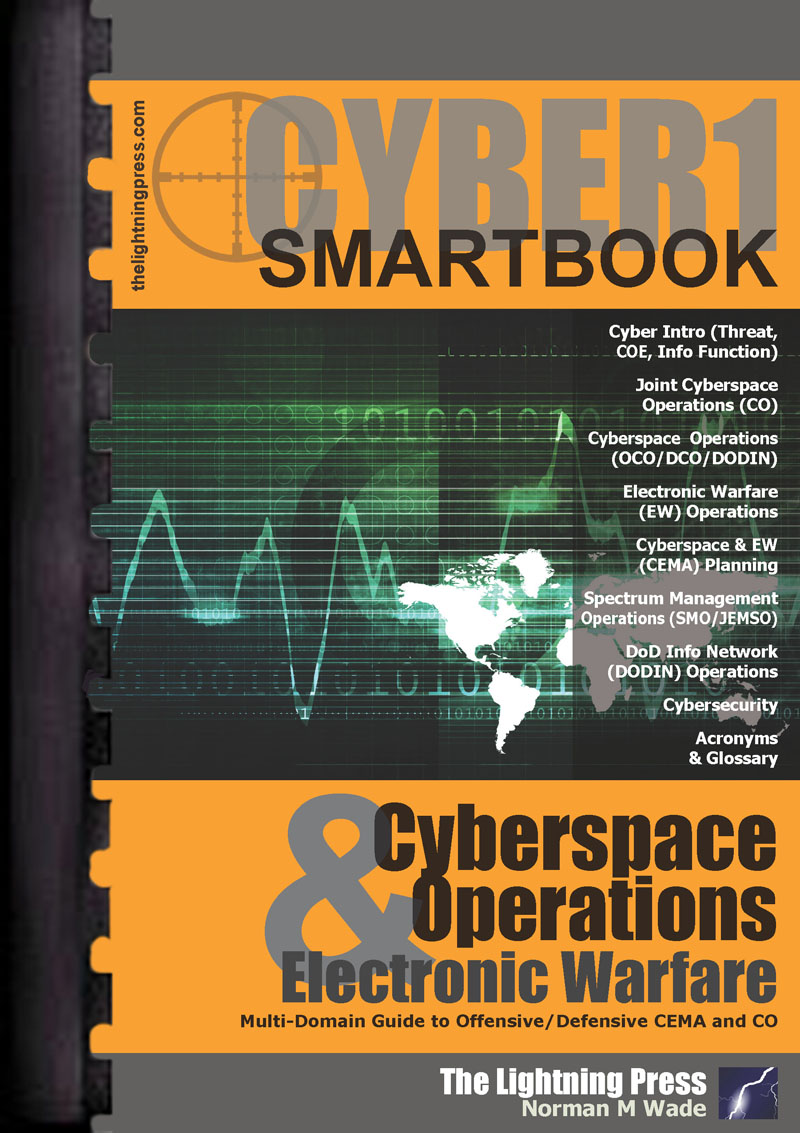
CYBER1-1: The Cyberspace Operations & Electronic Warfare SMARTbook (w/SMARTupdate 1)
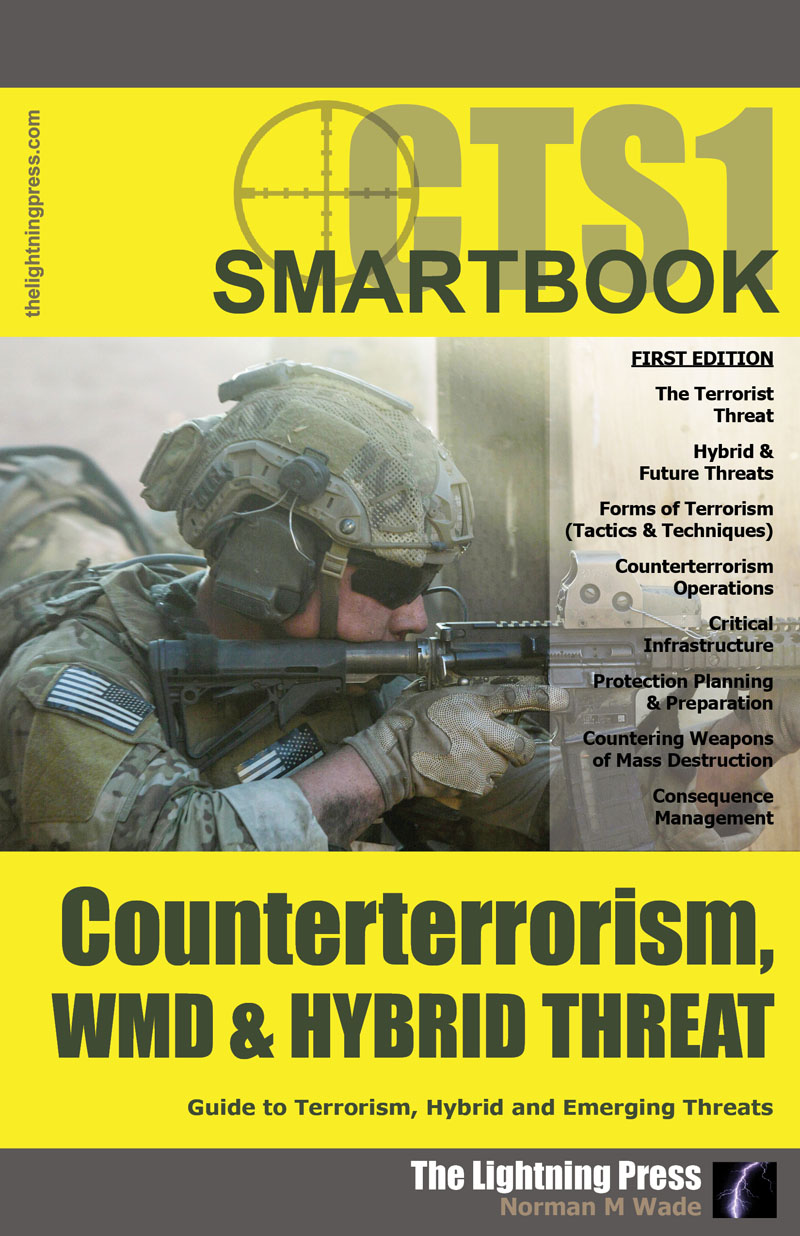
CTS1: The Counterterrorism, WMD & Hybrid Threat SMARTbook
Threat, OPFOR, Regional & Cultural
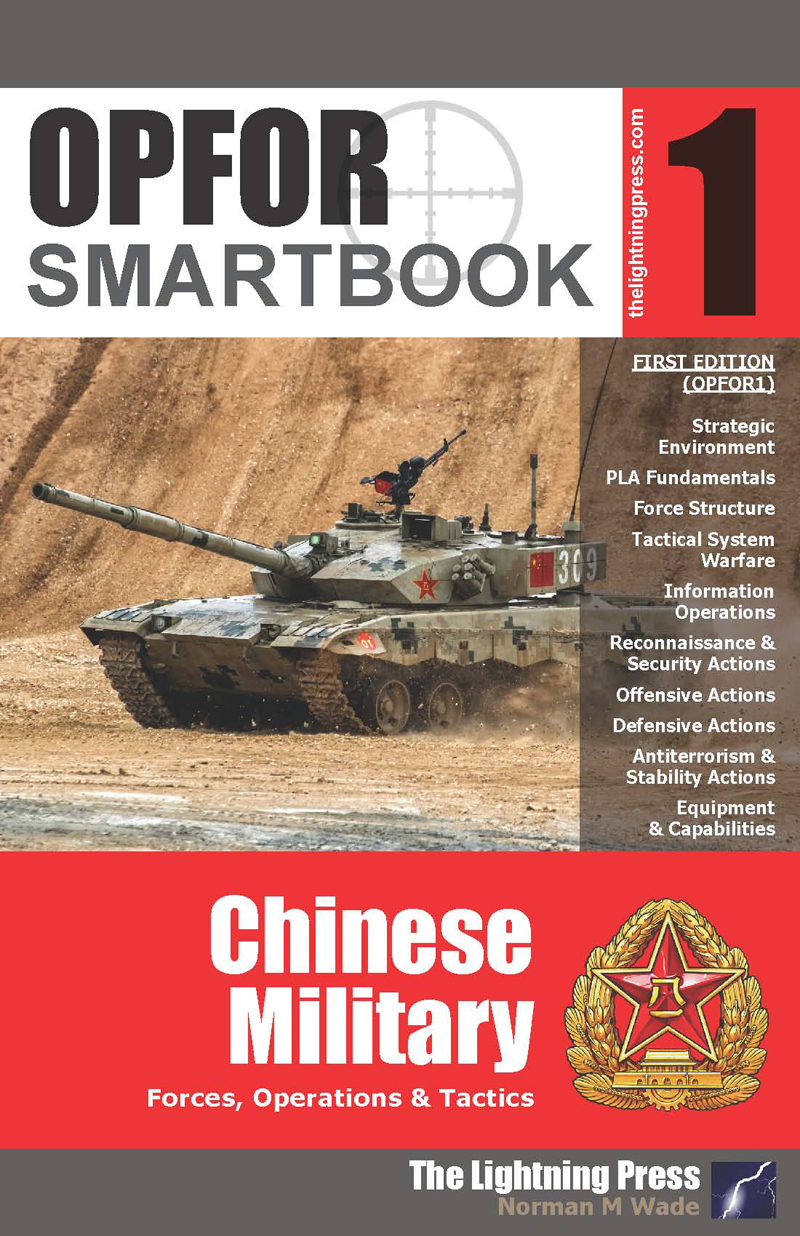
OPFOR SMARTbook 1 - Chinese Military
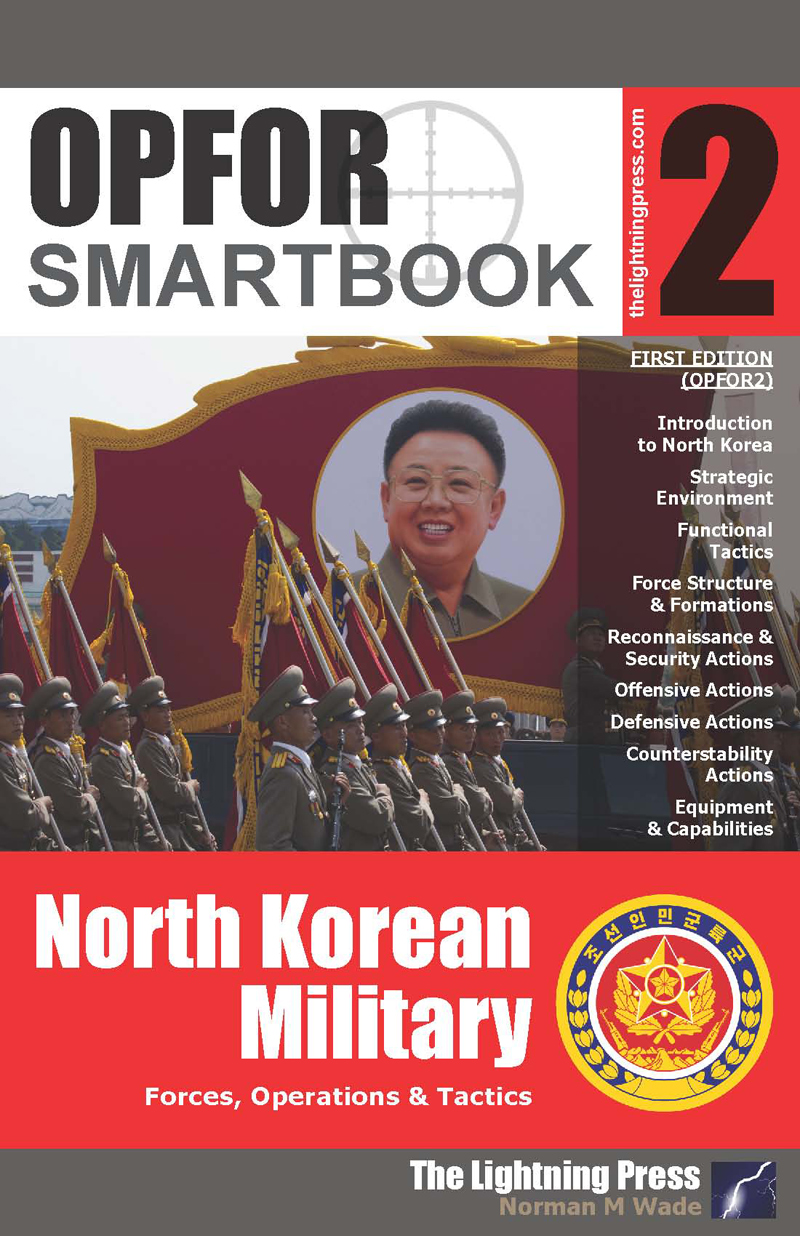
OPFOR SMARTbook 2 - North Korean Military
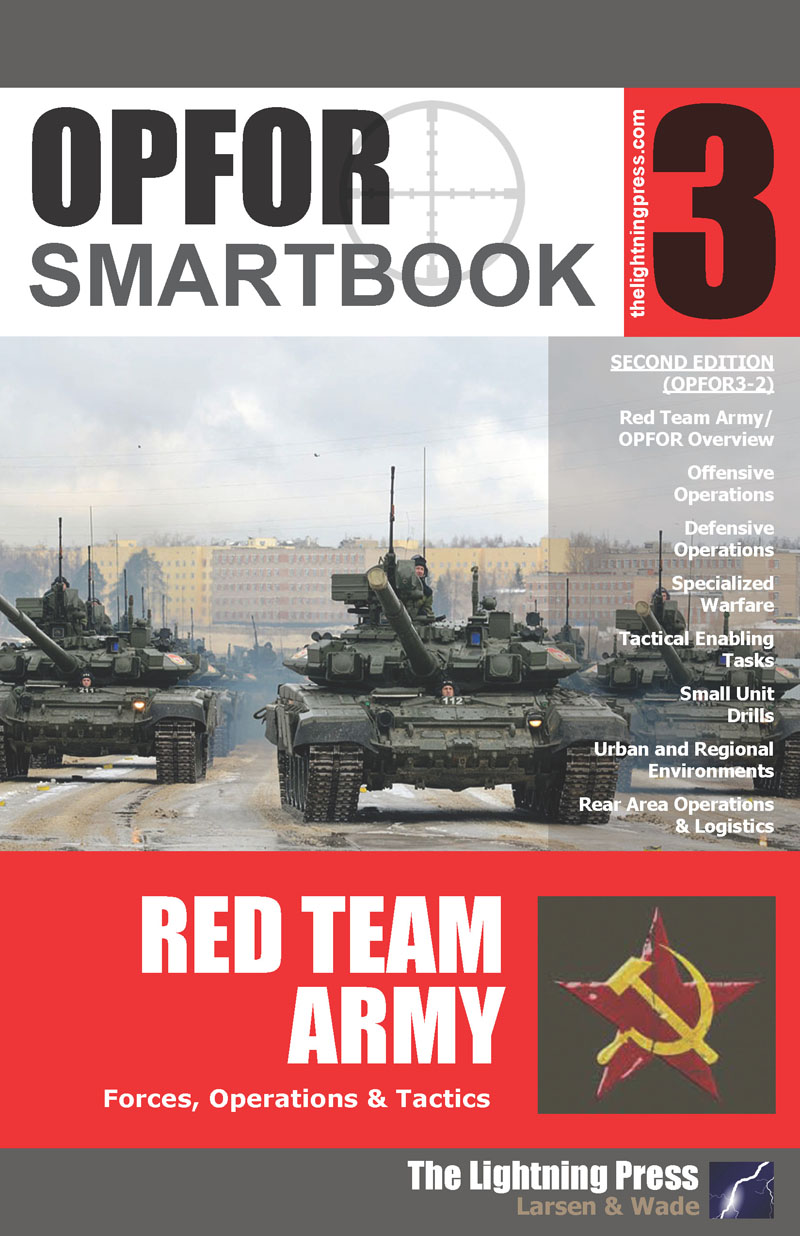
OPFOR SMARTbook 3 - Red Team Army, 2nd Ed.
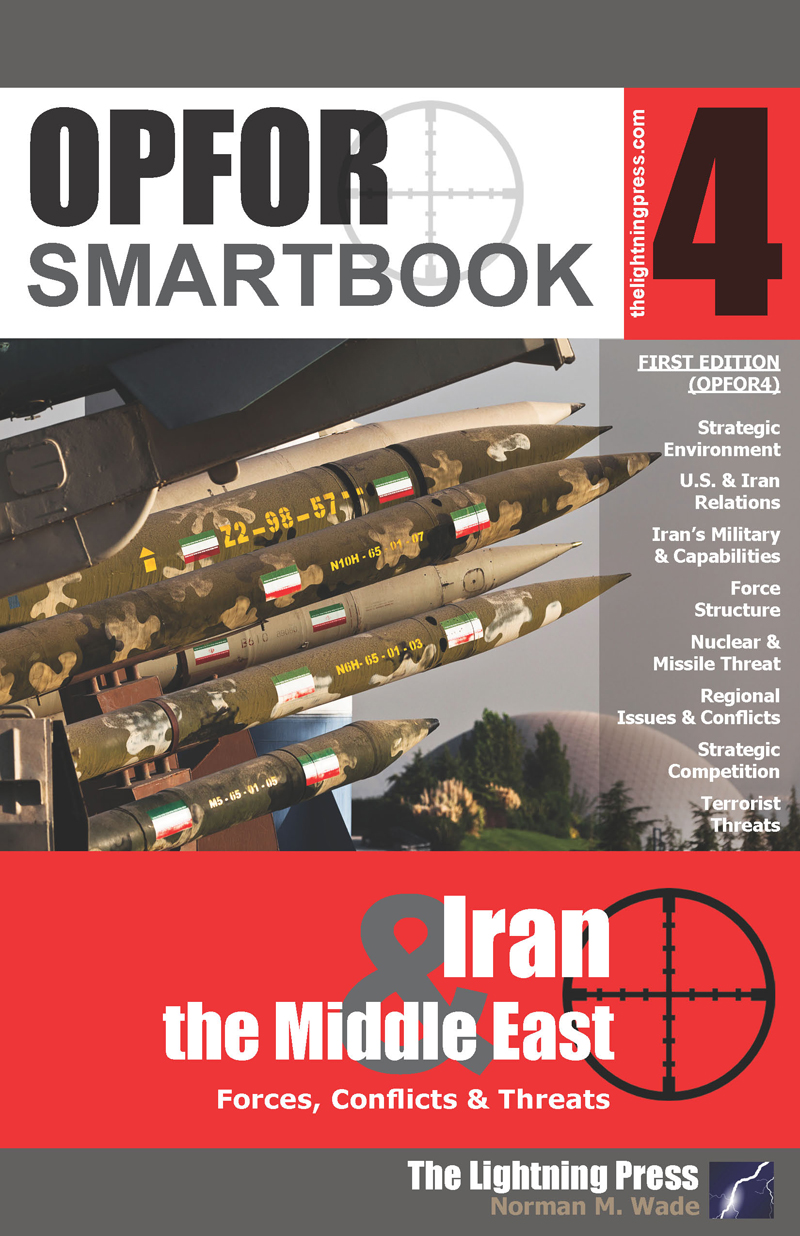
OPFOR SMARTbook 4 - Iran & the Middle East
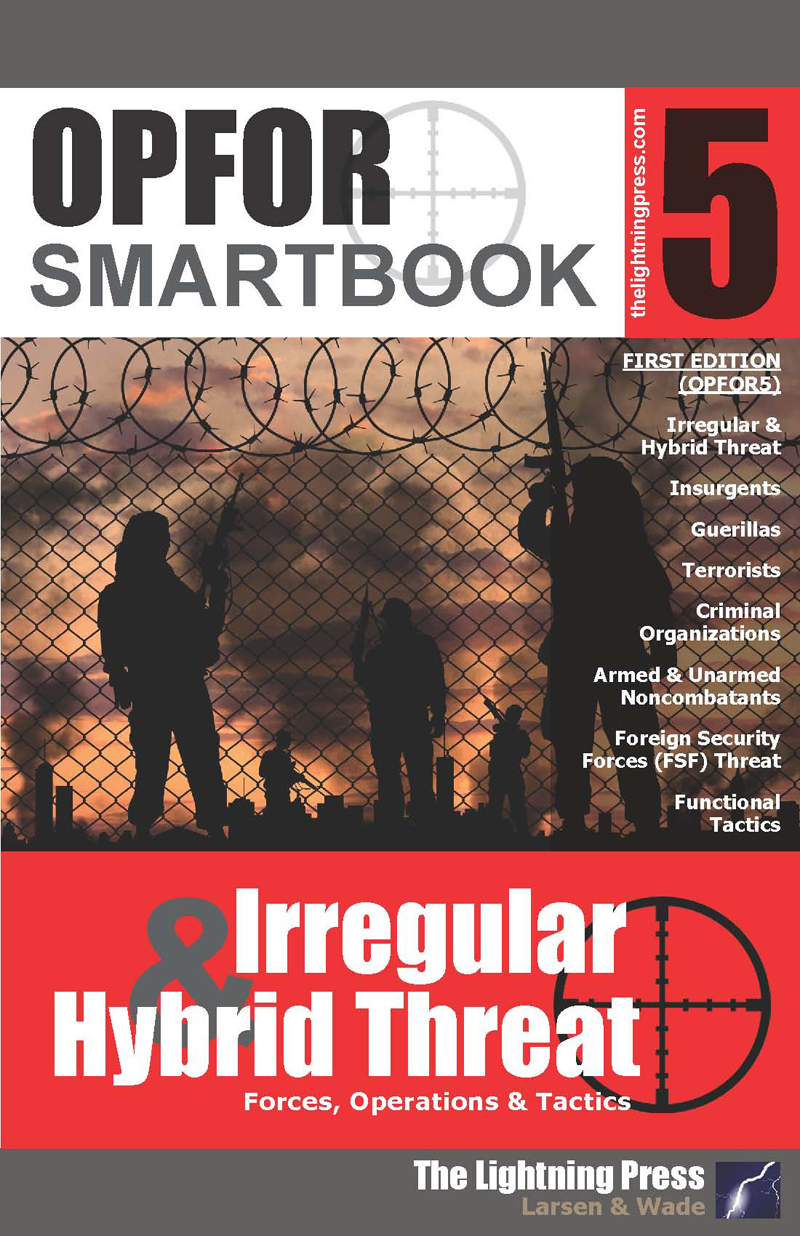
OPFOR SMARTbook 5 - Irregular & Hybrid Threat
Homeland Defense, DSCA, & Disaster Response
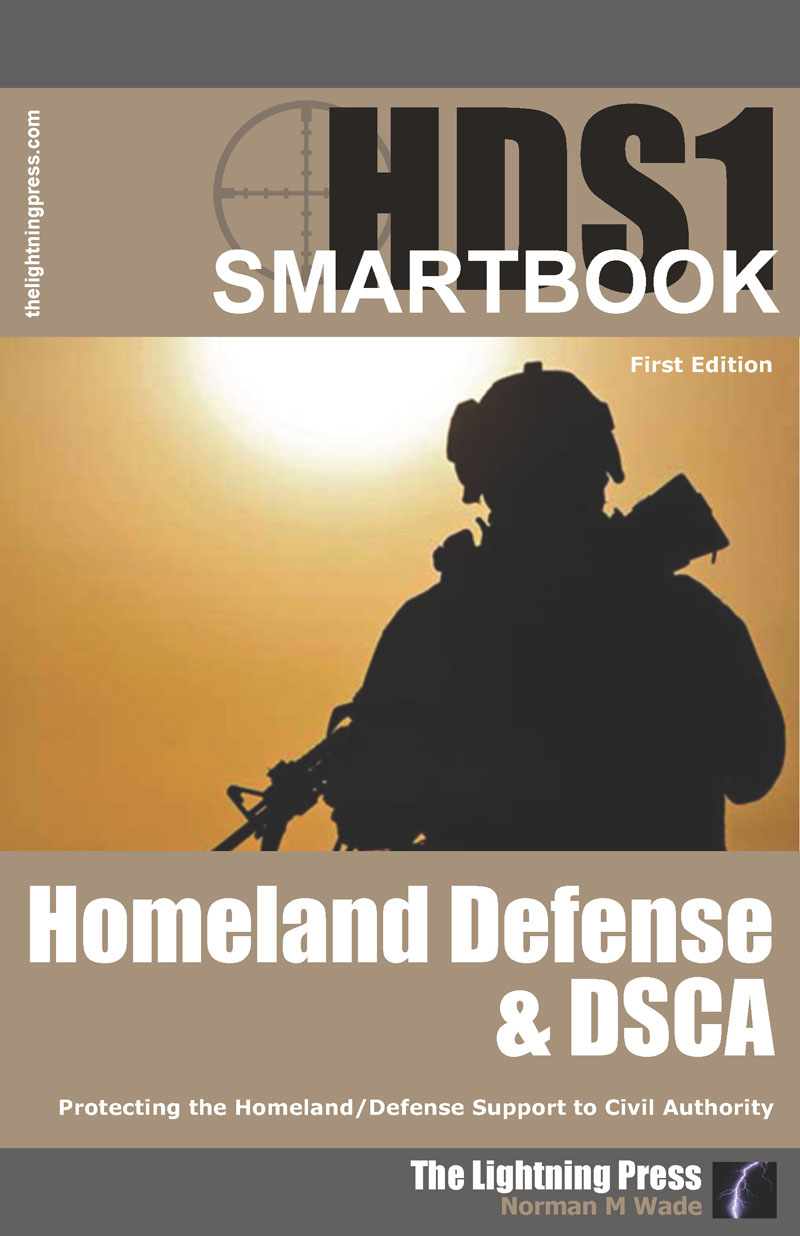
HDS1: The Homeland Defense & DSCA SMARTbook
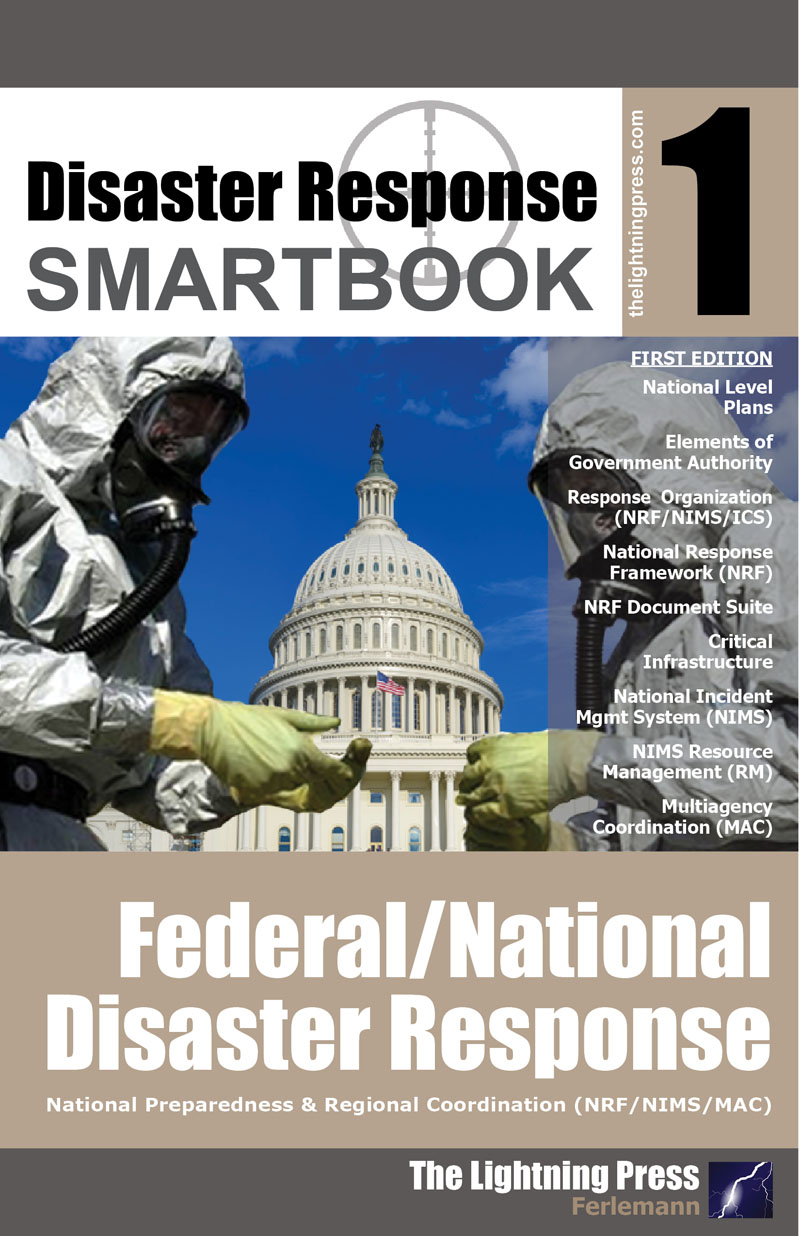
Disaster Response SMARTbook 1 – Federal/National Disaster Response
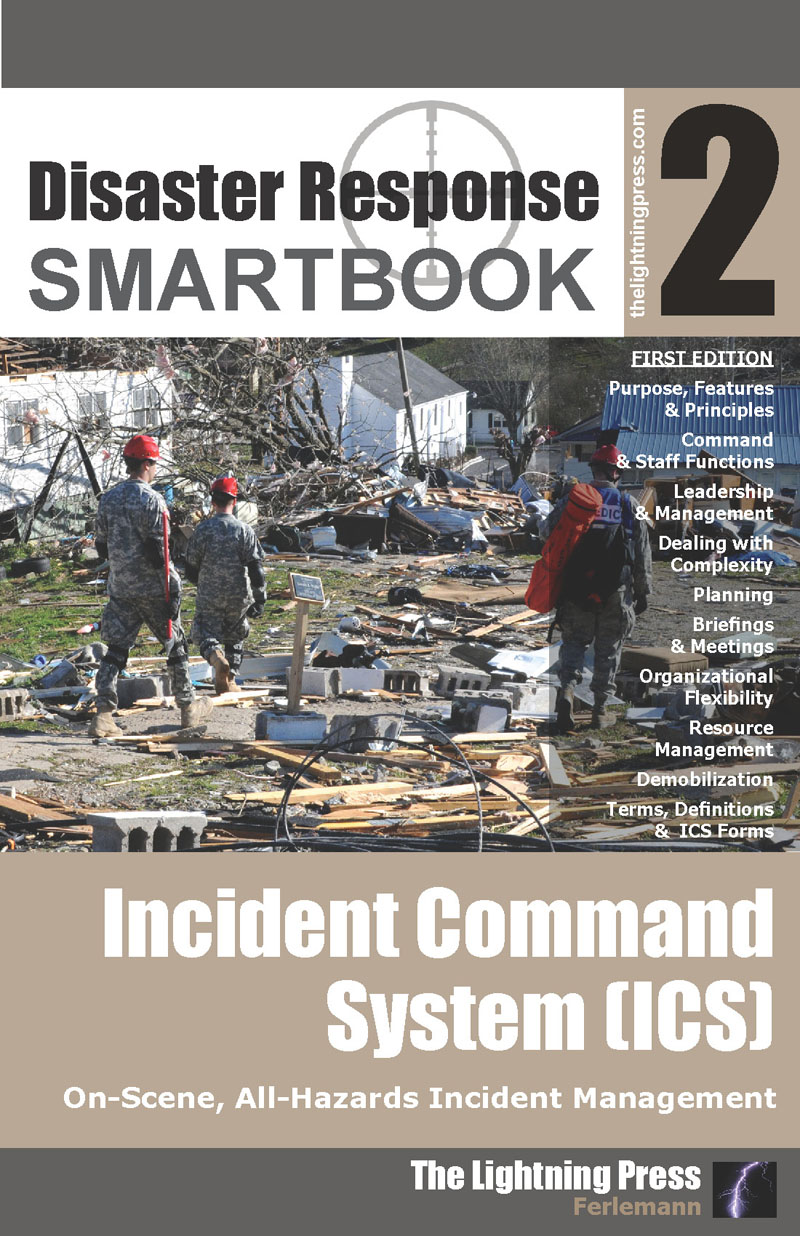
Disaster Response SMARTbook 2 – Incident Command System (ICS)
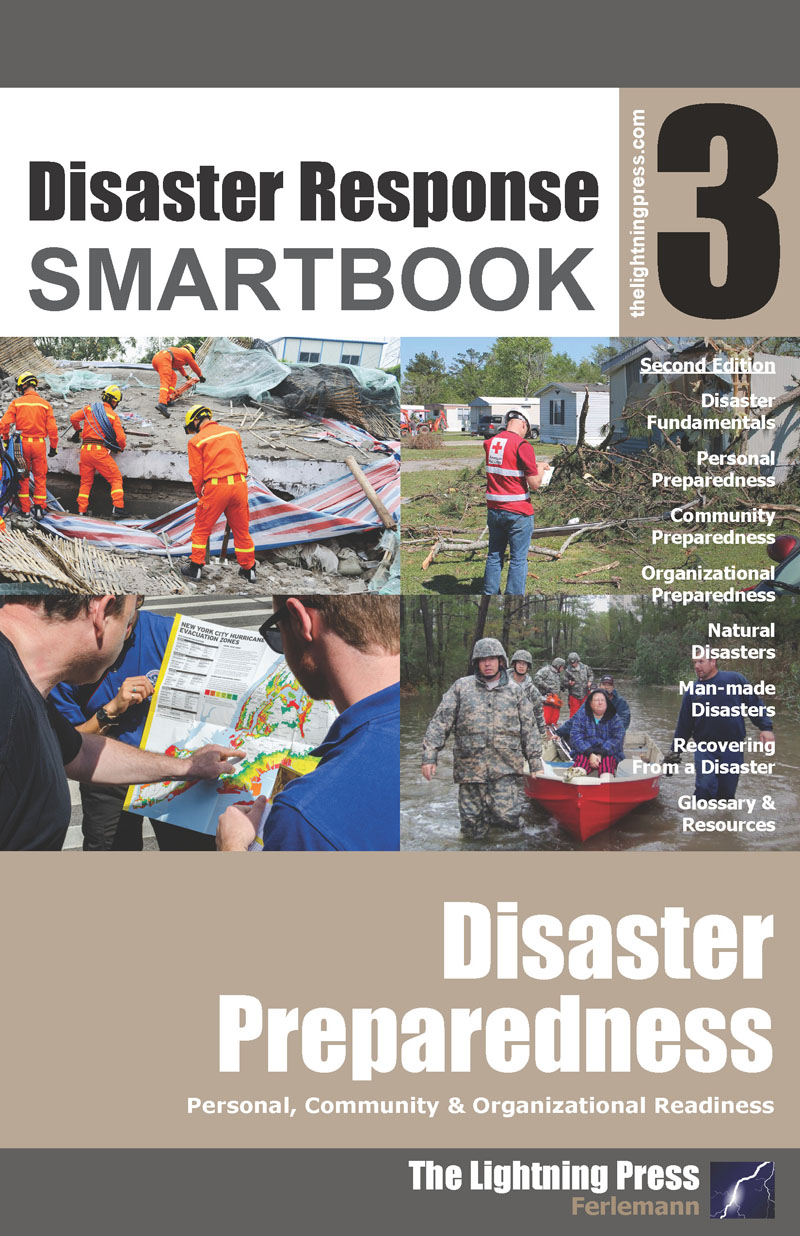
Disaster Response SMARTbook 3 - Disaster Preparedness, 2nd Ed.

CYBER1-1: The Cyberspace Operations & Electronic Warfare SMARTbook (w/SMARTupdate 1)
SMARTupdates
Books in Development
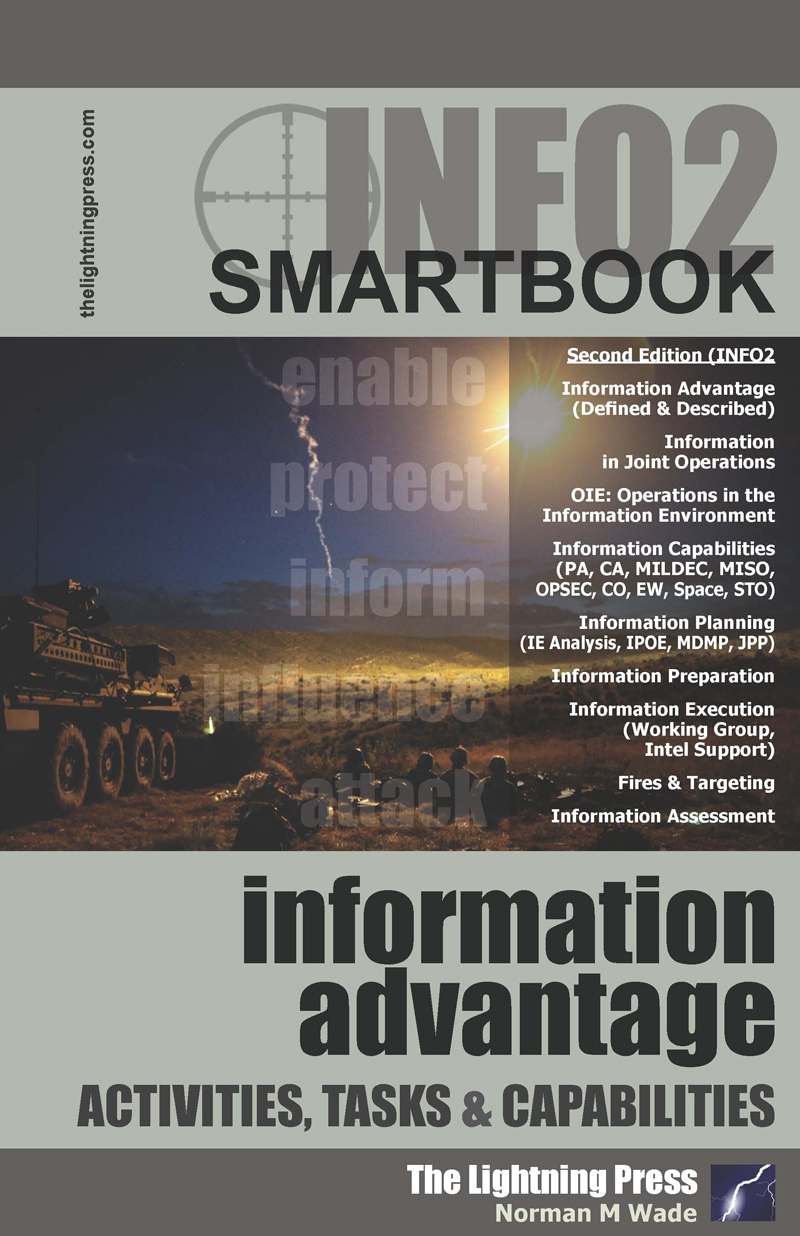
INFO2 SMARTbook: Information Advantage

Joint/Interagency SMARTbook 2 – Interagency Planning & Process
SMARTsets
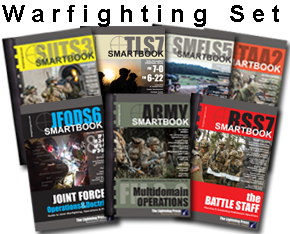
The ''WARFIGHTING'' SUPERset (7 books)
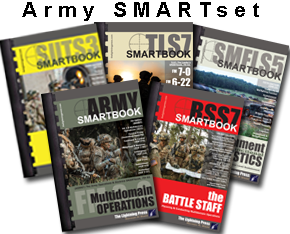
The ''ARMY'' SMARTset (5 books)
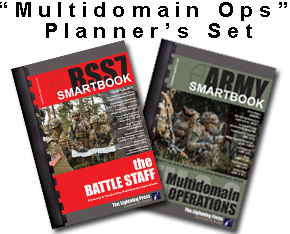
''Multidomain Operations'' Planner's SMARTset (2 books)
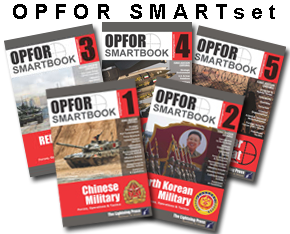
The ''OPFOR THREAT'' SMARTset (5 books)
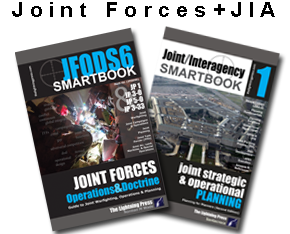
The ''JOINT FORCES + JOINT/INTERAGENCY'' SMARTset (2 books)
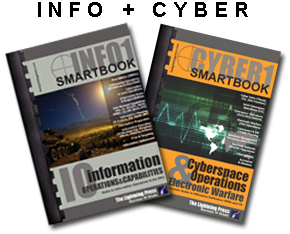
The ''INFO + CYBER'' SMARTset (2 books)
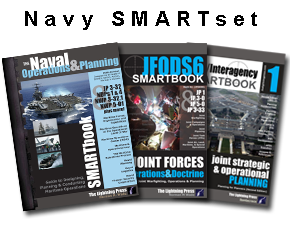
The ''NAVY'' SMARTset (3 books)
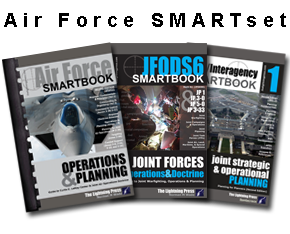
The ''AIR FORCE'' SMARTset (3 books)
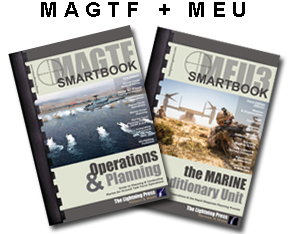
The ''MAGTF + MEU'' SMARTset (2 books)
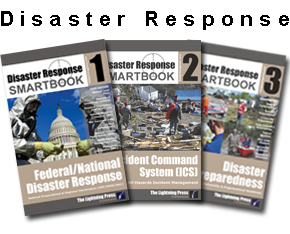
The ''DISASTER RESPONSE'' SMARTset (3 books)
AODS7: The Army Operations & Doctrine SMARTbook, 7th Ed.
ISBN-10 :1935886916
Release Date :Mar 1st, 2023
Norman M. Wade
Binding Type:Plastic Comb
Print Inside Pages:Black and White
Trim Size:5.5'' x 8.5''
Total Pages:352

Paperback Edition
Price: $42.95 $36.95

Bundle & Save (Paperback + Digital)
Price: $85.90 $49.95
Multidomain Operations
AODS7: The Army Operations & Doctrine SMARTbook, 7th Ed. (Multidomain Operations) is completely updated with the 2022 edition of FM 3-0. AODS7 focuses on Multidomain Operations and features rescoped chapters on generating and applying combat power: command & control (ADP 6-0), movement and maneuver (ADPs 3-90, 3-07, 3-28, 3-05), intelligence (ADP 2-0), fires (ADP 3-19), sustainment (ADP 4-0), & protection (ADP 3-37).
The Army’s primary mission is to organize, train, and equip its forces to conduct prompt and sustained land combat to defeat enemy ground forces and seize, occupy, and defend land areas. Army forces shape operational environments, counter aggression on land during crisis, prevail during large-scale ground combat, and consolidate gains.
Army forces achieve objectives through the conduct of operations. Operations vary in many ways. They occur in all kinds of physical environments and vary in scale of forces involved and duration.
Multidomain operations are the combined arms employment of joint and Army capabilities to create and exploit relative advantages that achieve objectives, defeat enemy forces, and consolidate gains on behalf of joint force commanders. Multidomain operations are the Army’s contribution to joint campaigns, spanning the competition continuum.The Army provides forces capable of transitioning to combat operations, fighting for information, producing intelligence, adapting to unforeseen circumstances, and defeating enemy forces. Army forces employ capabilities from multiple domains in a combined arms approach that creates complementary and reinforcing effects through multiple domains while preserving combat power to maintain options for the joint force commander.
Combat power is the total means of destructive and disruptive force that a military unit/formation can apply against an enemy at a given time. It is the ability to fight. The complementary and reinforcing effects that result from synchronized operations yield a powerful blow that overwhelms enemy forces and creates friendly momentum. Army forces deliver that blow through a combination of five dynamics: leadership, firepower, information, mobility, and survivability.
The warfighting functions contribute to generating and applying combat power. Well sustained units able to move and maneuver bring combat power to bear against the opponent. Joint and Army indirect fires complement and reinforce organic firepower in maneuver units. Survivability is a function of protection tasks that focus friendly strengths against enemy weaknesses. Information contributes to the disruption and destruction of enemy forces. Intelligence determines how and where to best apply combat power against enemy weaknesses. C2 enables leadership, the most important qualitative aspect of combat power.
Note: AODS7: The Army Operations & Doctrine SMARTbook (Multidomain Operations) is designed specifically to work hand-in-hand as a planner’s companion guide to BSS7: The Battle Staff SMARTbook, 7th Ed., with specific page references that lead to expanded content pertinent to understanding multidomain operations from FM 3-0. Save $14.90 when you order both together (bundle the print and digital versions together and save $74.80)! Read more here: https://www.thelightningpress.com/bookstore/smartset/multidomain-ops-planning-set-2-books/
Related Books
Discount sets with this book
MAGTF: The MAGTF Operations & Planning SMARTbook
ISBN-10 :1935886886
Release Date :Dec 17th, 2020
Andrew Milburn
Norman M. Wade
Binding Type:Plastic Comb
Print Inside Pages:Black and White
Trim Size:5.5'' x 8.5''
Total Pages:336

Paperback Edition
Price: $42.95 $36.95

Bundle & Save (Paperback + Digital)
Price: $85.90 $49.95
Guide to Planning & Conducting Marine Air-Ground Task Force Operations
The MAGTF Operations & Planning SMARTbook topics and chapters include Marine Corps roles & forces, the Marine Air-Ground Task Force (MAGTF), expeditionary operations, Marine Corps operations (ROMO, offense, defense, tactical operations, reconnaissance & security, tactical tasks, etc), planning considerations, the Marine Corps Planning Process (MCPP & R2P2), integrating processes (IPB, collection management, targeting, operational risk management, information management), and the six warfighting functions.
Primary references include MDCP 1-0, Marine Corps Operations (2018); MCWP 5-10, Marine Corps Planning Process (2018); ATP 2-01.3/MCRP 2-3A, Intelligence Preparation of the Battlespace (2014); MCTOG Tactical Marine Air-Ground Task Force Integration Course (TMIC) Handbook (2018); MCTOG Operations & Tactics Instructor (OTI) Guide (2011), MSTP Pamphlet 5-0.4, MAGTF Officer's Guide (2010); and more.
The Marine Corps organizes its operational forces as Marine Corps components and as Marine Air-Ground Task Forces (MAGTFs) in order to provide task organized, self-sustaining, multipurpose forces to the joint force or naval expeditionary force. These uniquely organized Marine Corps forces are capable of responding to a wide range of operational and tactical missions and tasks, providing an unmatched combination of deployment and employment options.
Expeditionary maneuver warfare is the Marine Corps capstone operational concept. It applies the doctrine of maneuver warfare to Marine Corps expeditionary operations to achieve desired effects across the spectrum of conflict. Expeditionary maneuver warfare focuses on the application of expeditionary military power at the right place, at the right time, and at the right level.
The Marine Corps approach to the range of military operations (ROMO) links MAGTF capabilities with the collective, coordinated use of both traditional and non- traditional elements of national power into a cohesive foreign policy tool, and focuses on the ability to be expeditionary through forward-deployed naval forces. The Marine Corps employs several planning processes. For units with staffs, the Marine Corps planning process (MCPP) is most appropriate. If time does not allow use of the full, six-step MCPP, the commander and the planners may use the rapid response planning process (R2P2).
Marine Corps warfighting functions encompass all military activities in the battlespace. Commanders and staffs integrate the warfighting functions and synchronize the force to adapt to changing circumstances throughout the operations process. They use several integrating processes to do this.Related Books
Discount sets with this book
MEU3: The Marine Expeditionary Unit SMARTbook, 3rd Ed.
ISBN-10 :1935886797
Release Date :Dec 17th, 2020
Norman M. Wade
Binding Type:Plastic Comb
Print Inside Pages:Black and White
Trim Size:5.5'' x 8.5''
Total Pages:336

Paperback Edition
Price: $42.95 $36.95

Bundle & Save (Paperback + Digital)
Price: $85.90 $49.90
Guide to Battle Staff Operations & the Rapid Response Planning Process
MEU3 is the third edition of the MEU SMARTbook, updated for 2020 with 34 pages of updated/additional material and a return of the original GBC plastic-comb binding. The Marine Expeditionary Unit (MEU) SMARTbook is designed to be a reference for MEU and PHIBRON Commanders, MEU and PHIBRON staffs and the commanders and staffs of the Major Subordinate Elements (MSE) and Naval Support Elements (NSE) of the ARG-MEU team.
The Marine Corps Planning Process (MCPP) is the basis for MEU staff planning. Planning is the art and science of envisioning a desired future and laying out effective ways of bringing it about. In war, planning can be essential to the ability to seize the initiative. In order to seize the initiative, we must be able to anticipate events and act purposefully and effectively before the enemy can. Planning mitigates crises by dealing with crisis situations before they reach crisis proportions.
The Rapid Response Planning Process (R2P2) is an accelerated execution of MCPP geared to Crisis Action Planning. The R2P2 process allows the MEU/PHIBRON to anticipate potential missions, create a set of standardized responses through analytical decision-making, and rehearse their responses to achieve full capability within six hours of receipt of a warning or execute order.
Rapid planning requires extensive training in the techniques and procedures associated with R2P2. It requires standardized, detailed, parallel, and concurrent command and staff actions using Standard Operating Procedures (SOPs) that are understood by all members of the unit.
The Marine Expeditionary Unit (MEU) SMARTbook helps to generate tempo and staff synergy in time-compressed situations through the use of “playbooks” for rapid planning and templates for efficient briefings.
Related Books
Discount sets with this book
The Naval Operations & Planning SMARTbook
ISBN-10 :0982485956
Release Date :Dec 1st, 2010
Norman M. Wade
Binding Type:Plastic Comb
Print Inside Pages:Black and White
Trim Size:5.5'' x 8.5''
Total Pages:320

Paperback Edition
Price: $42.95 $36.95

Bundle & Save (Paperback + Digital)
Price: $85.90 $49.95
Guide to Designing, Planning & Conducting Maritime Operations
Providing an outline of Navy operational-level fundamentals and concepts, command, control, and organization, The Naval Operations & Planning SMARTbook covers essential Navy keystone warfighting doctrine and maritime operations at the JFMCC/CFMCC, Fleet and JTF levels. It bridges between the theory of operational art and the practical specific guidance that Navy commanders and staffs require to accomplish their mission. Chapters and topics include maritime forces, organization and capabilities; maritime operations; maritime headquarters (MHQ) and the maritime operations center (MOC); the maritime operations process; naval planning; naval logistics; and naval theater security cooperation!
Unlike the other components of the joint force, the maritime component routinely conducts operations across all of the domains, described as air, land, maritime, space, and the information environment. The maritime domain is defined as “the oceans, seas, bays, estuaries, islands, coastal areas, and the airspace above these, including the littorals.” This joint definition has fundamental implications for the Navy’s role in joint operations. The Navy is the principal warfighting organization that conducts operations over, on, under, and adjacent to the seas: overlying airspaces, surfaces, sub-surfaces, and the ocean bottom, as well as the shoreline infrastructures that affect maritime operations.
The maritime domain also contains social, economic, political, military, and legal components. About 70 percent of the world’s surface is covered by the oceans and seas. Naval forces operate from the deep waters of the open ocean to the generally shallower waters fronting the coastlines of the continental land mass and large offshore islands. About 50,000 large ships carry approximately 80 percent of the world’s trade. Each year 1.9 billion tons of petroleum, or some 60 percent of all oil produced, are shipped by sea. Some 75 percent of the world’s maritime trade and 50 percent of its daily oil consumption pass through a handful of international straits. There are some 4,000 ports involved in maritime trade, including 30 so-called mega-ports.
Navy forces demonstrate the nation’s resolve and intentions from international waters. Forward-deployed Navy forces are often times the nation’s first responders to events requiring military response outside the homeland. When adversarial action occurs beyond our borders, as a key element of the joint force that is readily capable of employing credible combat power forward, Navy forces are often times the first on-scene force to exercise the deterrence phase of a joint operation or campaign.
In contrast to the war on land, sea control is not obtained by occupying or capturing a certain ocean or sea area. It is not obtained through the permanent presence of one’s fleet. There are no front lines at sea and no fortified positions by which one can control the territory. The sea or ocean area is invariably abandoned by the victorious side regardless of whether the opponent was completely defeated or not. Sea control means that more or less by the destruction of the enemy fleet one can accomplish tasks without serious opposition from the enemy.
Related Books
Discount sets with this book
AFOPS2: The Air Force Operations & Planning SMARTbook, 2nd Ed.
ISBN-10 :1935886754
Release Date :Jan 7th, 2019
Norman M. Wade
Binding Type:Perfect Bind
Print Inside Pages:Black and White
Trim Size:5.5'' x 8.5''
Total Pages:376

Paperback Edition
Price: $42.95 $36.95

Bundle & Save (Paperback + Digital)
Price: $85.90 $49.95
Guide to Curtis E. LeMay Center & Joint Air Operations Doctrine
AFOPS2: The Air Force Operations & Planning SMARTbook, 2nd Ed. (Guide to Curtis E. LeMay Center & Joint Air Operations Doctrine) is the second edition of our Air Force SMARTbook. Topics and references of the 376-page AFOPS2 include airpower fundamentals and principles (Volume 1), command and organizing (Volume 3); command and control (Annex 3-30/3-52), airpower (doctrine annexes), operations and planning (Annex 3-0), planning for joint air operations (JP 3-30/3-60), targeting (Annex 3-60), and combat support (Annex 4-0, 4-02, 3-10, and 3-34).
As the nation’s most comprehensive provider of military airpower, the Air Force conducts continuous and concurrent air, space, and cyberspace operations.
Airpower exploits the third dimension of the operational environment; the electromagnetic spectrum; and time to leverage speed, range, flexibility, precision, tempo, and lethality to create effects from and within the air, space, and cyberspace domains. From this multi-dimensional perspective, Airmen can apply military power against an enemy’s entire array of diplomatic, informational, military, and economic instruments of power, at long ranges and on short notice.
The Air Force conducts operations along a varying scale of military involvement and violence, referred to as the range of military operations (ROMO). They range from continuous and recurring operations such as military engagement, security cooperation, and deterrence; through smaller-scale contingencies and crisis response operations, as well as irregular warfare; to major operations and campaigns such as declared wars.
The Air Force designs, plans, conducts, and assesses operations according to an effects-based approach (EBAO). There are some significant differences between the focus of strategy during steady-state conditions and the focus during contingencies and major operations. Contingency planning and steady-state planning employ a common logical approach and process referred to as the common framework for operations, which helps to foster coherence in Air Force strategy creation.
The JFC’s estimate of the operational environment and articulation of the objectives needed to accomplish the mission form the basis for determining components’ objectives. The JFACC uses the JFC’s mission, commander’s estimate and objectives, commander’s intent, CONOPS, and the components’ objectives to develop a course of action (COA). When the JFC approves the JFACC’s COA, it becomes the basis for more detailed joint air operations planning—expressing what, where, and how joint air operations will affect the adversary or current situation.
Targeting is the process of selecting and prioritizing targets and matching the appropriate response to them, considering operational requirements and capabilities. The targeting cycle supports the joint force commander’s (JFC) joint operation planning and execution with a comprehensive, iterative and logical methodology for employing ways and means to create desired effects that support achievement of objectives.
Related Books
Discount sets with this book

